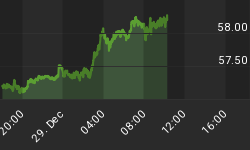All those new dollars being created by an apparently-still-panicked Fed are pushing up asset prices across the board (with housing the only exception) and pushing the dollar down to near-record lows versus other currencies. The charts look eerily like a replay of 2007, which, of course, is exactly what policymakers want. Rising asset prices, according to the prevailing logic, will get us spending and borrowing again and return the economy to self-sustaining expansion. 2006 and 2007, for the people running this show, were the good old days.
What they seem to be missing is that these trends contain the seeds of their own destruction, just as they did four years ago. Oil, for instance, is back above $100 a barrel, which translates into $4 a gallon gas, which amounts to a sizable tax increase on the consumers who are supposed to start spending again. CNBC just reported that gas sales have fallen for five straight weeks.

Same thing for food. Ag commodity prices are through the roof, which is gradually translating into higher prices at grocery stores and restaurants. Consumers, as a result, will be eating out a lot less in the year ahead -- and will still have fewer dollars to spend on other things.

In the financial markets, precious metals are blowing away old records...

For policymakers, gold and silver occupy a kind of shadow world. They're not "real" money like dollars and euros, but for some inexplicable reason people still respect them. Central bankers worry that they're being unreasonably blamed for their inability to keep their currencies stable versus these atavistic lumps of metal. As masters of their universe, they don't like being contradicted by the rabble in the marketplace. And as managers of fictitious currencies they're terrified of an "emperor's new clothes" scenario in which everyone suddenly sees the con they're running. So they're watching gold in particular with rising anxiety.
...and the dollar is approaching the low it hit just before the world fell apart in 2008.

This too is a desired goal of US policy, because it makes US exports more attractive for the rest of the world. But of course it also makes imports more expensive, which raises the question of how much lower the dollar can go before headline writers put currency depreciation and rising food/energy prices together. A series of New York Times articles speculating about the end of dollar hegemony (and explaining the nature of money) is the Fed's nightmare because it will get people to thinking about what exactly a paper currency is. Once that train leaves the station its inevitable destination is the conclusion that a fiat currency isn't really anything. It's just a consensual hallucination founded on our trust for the people managing it. Which in turn leads newly-awakened citizens to check out those YouTube videos of Bernanke and Greenspan getting pretty much everything wrong, documentaries like Inside Job, and the ongoing hearings of Ron Paul's subcommittee, in which Fed and Treasury officials are revealed to be mumbling incompetents and frauds.
As an understanding of the scam spreads, consumers and investors start converting their dollars into other currencies and hard assets and the game is over. A crisis of confidence sends the dollar into free-fall.
This of course is to be avoided at all costs, which makes the dollar's recent decline versus food, energy, and other currencies such a dilemma. It can't keep falling indefinitely, so if it doesn't stabilize on its own -- i.e., if gold, oil and food don't stop going up -- action will have to be taken to stop it. With Europe and China now raising interest rates, how long will it be before the Fed is forced to follow suit and start sucking liquidity out of the system? And how long after that before everything that's been going up in concert starts to fall together?
















